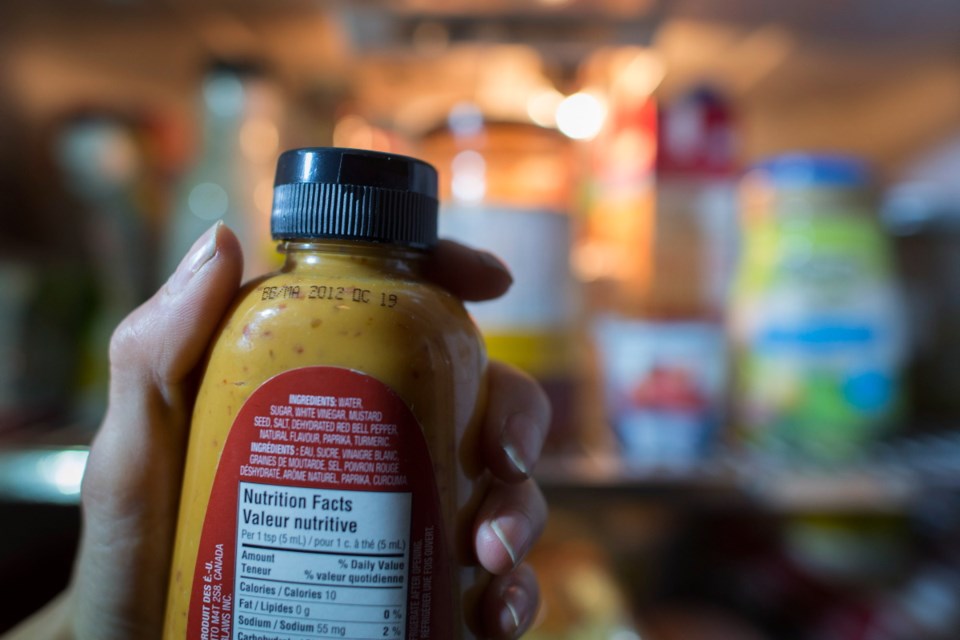TORONTO — Should you worry about eating food if the best-before date on the label has come and gone?
That depends on whether it’s a can of tomatoes or a carton of milk.
Best-before dates, sometimes called durable-life dates, are required on food with a shelf life of less than 90 days, like milk. Products with an expected shelf life of more than 90 days, like canned tomatoes and dry pasta, need not be labelled because the dates are not tied into safety.
“The dates originated as an inventory management tool,” says Getty Stewart, a professional home economist in Winnipeg. “They are really all about the quality, freshness, taste, colour of the product.”
But once a jar or package is opened, the best-before date is irrelevant because its internal atmosphere has been disturbed. Food safety and longevity are then up to how the item is handled by the consumer — milk left on the counter or groceries left too long in a hot car won’t keep as long.
“The rule of thumb is that you smell it and you look at it — and literally that’s the best thing,” says Keith Warriner, a professor in the food science department at the University of Guelph.
“The best-before date is only a guide. If you’ve abused it, it’s going to spoil much quicker. So use your senses — and your senses are very good because they can smell when things aren’t right.”
While Health Canada advises not to consume any food past its best-before date, Stewart calls that advice “just way too conservative and leads to food waste.”
“I think it’s a cop-out on their part for not having a better answer for people. Canada Food Inspection Agency is a little more lenient, and then some other sites may have questionable authors; we don’t know who really is writing that information.
“So I think the answer lies somewhere in the middle in using your own experience and judgment and your own information about how I stored this product.”
Typically, best-before dates are conservative, so people are throwing away perfectly good food, says Warriner.
“Sometimes retailers don’t want a long shelf life because if they can sell products and you throw them out you’re going to go back and get some fresh ones,” says Warriner.
He advises sticking to the best-before date when it comes to items like deli meats, hot dogs and soft cream cheese. Their high moisture content can support the growth of Listeria.
Consumers should also be wary of vacuum-sealed ready-to-eat meals, which have a 15-day shelf life “because of botulism risk, even though they might taste and look good,” says Warriner.
Retail-packed items must have a “packaged on” date plus a “best before” or “use by” date. This applies to foods like cut-up fruit and vegetables, store-packed meats, and bread, muffins and cakes baked on the premises.
Warriner is often asked whether it’s OK to cut mould off fruit and eat the seemingly unaffected portion.
“I always advise not to do that. With fruit, especially, if you get mould growth you could potentially have mycotoxins, which don’t kill you instantly but they’re not good for you. They’re carcinogenic.”
And don’t pick through a berry package looking for ones without mould. “Moulds are mobile. They don’t just stick to one strawberry,” he says.
But mould can be cut off hard cheese, like cheddar, which has a low moisture content.
“Because it’s fairly solid the mycotoxins don’t diffuse as quick or as much,” Warriner says.
Canned foods like tomatoes can be kept for several years. There’s a risk factor if a can is dented or kept in a damp area. It may start rusting and air holes can develop, allowing botulism to enter.
Stewart says she’s not surprised people are confused.
“In my cupboard right now I have two jars of pickles. One has a best-before date and the other one doesn’t,” she says. “As a consumer what am I supposed to take from that?
“And then it makes me question how do they set best-before dates?”
In her research, she hasn’t been able to track down rules from a regulatory body on how manufacturers must arrive at a best-before date.
When Warriner asked one company how it tackled the task, he was told a product would be left outside or in a cool room and looked at daily. When they didn’t the quality was acceptable, they set a best-before date.
Expiry dates fall into a different category altogether. They are required on only a few products in which the nutritional components must be guaranteed, like infant formula, formulated liquid diets for people using oral or tube feeding methods, foods used in very low energy diets that are prescribed by a physician and dispensed by a pharmacist, meal replacements and nutritional supplements.
The Canadian Food Inspection Agency recommends these products not be consumed past the expiry date because the nutrient content stated on the label may have degraded. They should be discarded.



